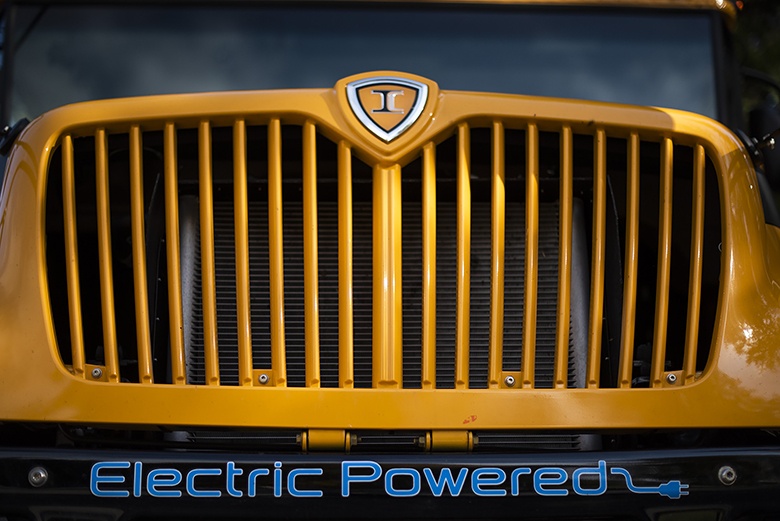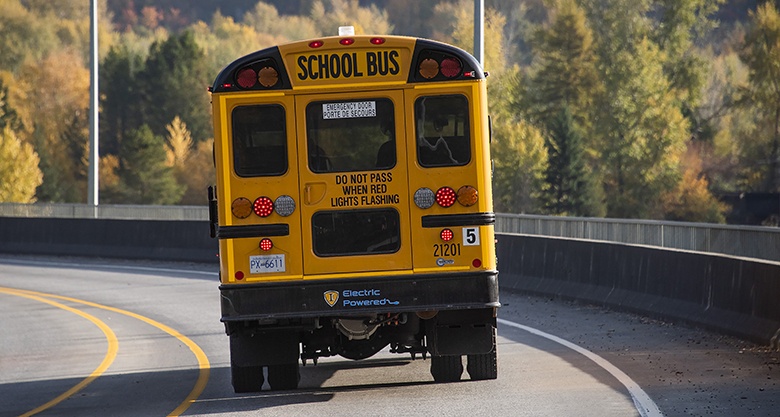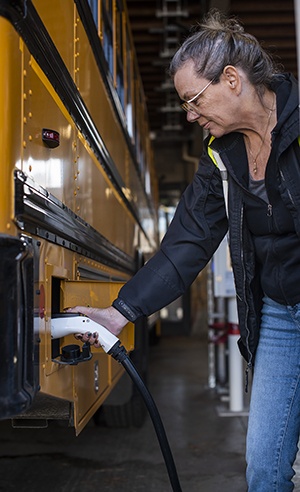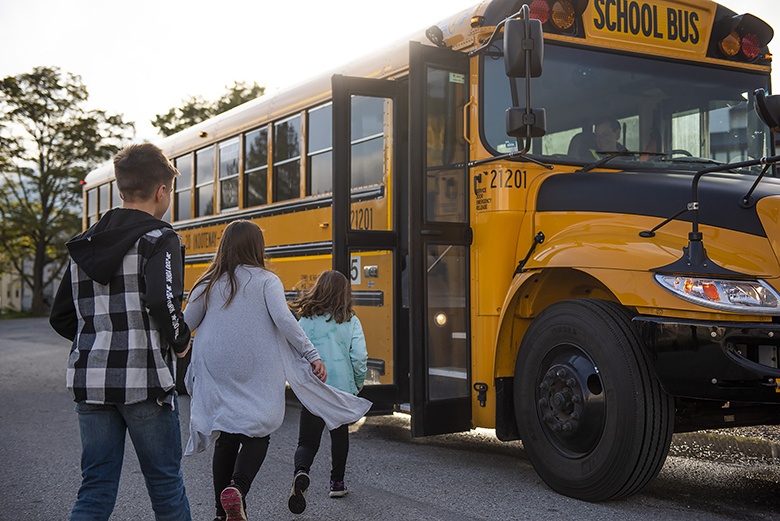
In the move toward vehicle electrification, the pupil transportation industry has been one of the first to see widespread adoption. Electrification is the way of the future, and school buses will be front and center in that journey.
But moving a school bus fleet to all-electric is more than just purchasing a bus. There are many factors to consider, and the process can be lengthy and complicated – not to mention costly. This is something IC Bus – the school bus brand of Navistar – recognizes and is working to help engineer.
With the TRATON GROUP’s trade and acquisition of the company over the summer of 2021, Navistar has seen some exciting leadership and organizational changes in 2022. Trish Reed, vice president and general manager of IC Bus, said that new leadership has renewed the company’s focus on energy and sustainability.
“With TRATON, we have a model that looks at various thousands and thousands and thousands of inputs,” she said. “Our model puts all the available grants and the subsidies aside, and it really looks at just electric adoption. Under that model, we foresee electric school buses being the predominant IC Bus product by 2030, as well as the main bus type being sold across the industry. It’s an exciting time.”
But with that excitement, Reed said, comes change management for districts looking to electrify.
“We all know electric is the right thing to do in the school bus market and there is a right way to do it if we want this to be successful in the long run,” she said. “I care less about actually selling electric buses than I do making sure our customers have a successful start on electrified fleets.”
To that end, the electrification process becomes about much more than the product itself. IC Bus has outlined what it calls the 5 Cs approach to help districts make the switch efficiently and effectively. The 5 Cs approach consists of: Consulting, Charging, Constructing, Connectivity, and Conserving.
With a strong market position, leading capabilities, and an experienced eMobility solutions team, IC Bus is the partner that can streamline electric adoption and implementation.
Making the 5 Cs a Reality
The 5 Cs approach incorporates the entire process needed to successfully transition and operate a fully electrified school bus fleet. The IC Bus team works with fleet managers and school districts through every step of the process to develop robust zero-emissions strategies that best fit customer needs.
“We recognize that electrification represents a whole ecosystem and not just the vehicle itself,” said Kelly White, IC Bus director of eMobility business development. “This transition is new for our customers, and entails grant funding as well as infrastructure. There are many key pillars to a successful electrification transition.”
Consulting – The consulting process includes the evaluation of route mileage, morning versus afternoon routes, the time between runs, and specifications — all vital for identifying battery electric vehicle (BEV) requirements and efficiencies. Additionally, the team is equipped to assist with educating on all available funding sources, grants, and tax incentives.
White said that IC Bus wants to ensure that when the bus shows up at a customer’s district, they are ready to fully utilize the vehicle and its infrastructure. “We want to make sure that the vehicle itself is operable and is suitable for the routes it will be running.”
“It is important that we look at the customer’s routes relative to the vehicle’s range,” White said. “Our recommendations will then deal with optimal routing, or even what type of battery pack the customer should use.”
Reed added that the electric CE Series comes with two battery configuration options, ranging from 135 miles to upward of 200+ miles on a single charge. IC Bus also offers the only electric school bus with three levels of regenerative braking, to extend the vehicle’s range between charging.

Charging – Charging and infrastructure are also critical factors in the consultation phase, largely because charging requires additional building and Electric compatibility. for districts trying to make the switch.
“We look at the routes, timeframes between runs that would allow for charging, kilowatts from the utility company, peak versus non-peak charging, and time of day for charging vehicles – because all of that will impact the total cost of ownership,” she said. “We also discuss the size of vehicles, size of operation, and numbers of buses, to really tailor the recommendation as to what a customer needs from a charging and infrastructure standpoint.”

Constructing – IC Bus constructs all school buses for electrification in its Tulsa, Oklahoma, plant. The construction is tied directly to the customer’s needs that were identified during the consultation phase, and the buses are then manufactured to specifications meeting those needs.
Connectivity – White said connectivity is one of the largest and most overlooked pillars of the electrification ecosystem. This means not only understanding kilowatt hours per mile and energy consumption, but it also impacts charging capabilities.
“There must be a successful ‘handshake’ between the bus and its charging system,” White said. “The process must include a solid connectivity platform between the bus and its charging platform. Furthermore, the transportation director or business manager should be able to pull up the platform from their office and see how the vehicles are operating, and whether or not they are charging.”
Having those key tools for customers is a critical part of the charging process, and the IC Bus OnCommand Connection remote diagnostics system does so by interfacing between the charging software and school buses.
Conserving – The fifth “C” is all about looking ahead – how can these batteries be used? What will be the optimal route for an electric vehicle entering its tenth, or even twelfth year of service? Even beyond that, once the battery’s life exceeds that of the vehicle itself, how can the energy be used to power alternative sources?
“Do you recycle? Do you remanufacture? Can you repurpose the battery in a new way? We look at all of these opportunities early for our customers,” White said.
Reed added that the CE Series lends itself to longer life and better serviceability thanks to certain features inherent to the model. The electric CE models are built in the same Tulsa facility as all of Navistar’s school buses. It allows IC Bus to leverage parts and componentry so that longtime customers are still familiar with the vehicle even after making the switch to electric.
Furthermore, IC Bus takes full advantage of its expansive dealer network to ensure serviceability and maintenance, as well as the rest of the vehicle’s components.
“Service after the sale has always been a key part of the IC Bus success, and that is continuous as we shift toward more electric models,” Reed said. “It might look a little different than a traditional IC Bus, but our dealers are ready to make the transition as seamless as possible for our district customers.”

British Columbia School Districts Go Electric
In a major step along the electrification journey, IC Bus delivered its first electric CE Series school buses to Canada. The buses are part of a larger order for 18 Type C electric school buses for British Columbia School Districts.
British Columbia began taking steps toward full electrification in 2019 and, after meeting with IC Bus and its dealer, Western Canada Bus, wanted to move quickly.
“The government of British Columbia, which operates most school buses in the province as a public fleet, had decided in 2018 that they were going to invest in zero-emission public fleet vehicles,” said Joel Landry, school and commercial account manager for Western Canada Bus. “And they were seeking a direct replacement of existing internal combustion engines in public fleet vehicles – meaning they did not want to purchase two electric vehicles just to replace one diesel bus. The range and capability needed to make it a 1:1 replacement.”
From there, the Association of School Transportation Services of British Columbia (ASTSBC) began exploring vendors that could fulfill those needs. Frank Marasco, ASTSBC manager, said the spec’ing process was thorough but rewarding.
“We put together a spec that included our needs in British Columbia – for power, for climate control, and other issues,” Marasco said. “We were impressed that IC Bus, before selling a single bus in our province, made multiple visits with the head of their electrification division. Before even making a sale, they used British Columbia as a sort of testing ground for their electric bus.”
Marasco said that this process was critical and helped ensure that the buses perform according to local specs.
“IC Bus really came to the table, and worked with us to ensure their vehicles meet our requirements,” Marasco said. “I’m happy to say that the buses have performed optimally so far.”
“In British Columbia, the school divisions owned around 1,250 buses with another 500 that are operated by contractors,” he added. “And of those 1,250, the objective is to get 40 percent to zero-emission by 2030. We replace approximately 100 buses per year (under normal bus life cycles), and now about 40 percent of those new buses each year will be electric vehicles.”
Marasco added that there are learning curves, particularly in assessing data between the vehicles and their chargers – but he is confident that the districts and IC Bus are working toward making that seamless, too.
“In British Columbia, we have a challenging climate for electric vehicles, as well as a challenging route profile,” Landry said. “Putting the 5 Cs into action was important, since most of these issues were worked out in the consulting phase.”
“In the end,” he said, “we found the process is most about change management, rather than learning an entirely new mode of transportation. IC Bus and Western Canada Bus are able to deliver a product that accounts for the initial anxieties held by districts, and follows up with performance and serviceability on the back end.”
The shift to zero-emission vehicles continues to accelerate, and school bus fleets will lead that charge. As school districts and fleet managers explore their own path toward electrification, IC Bus will continue to partner with customers ensuring long-term successful adoption and implementation of electric school buses.


